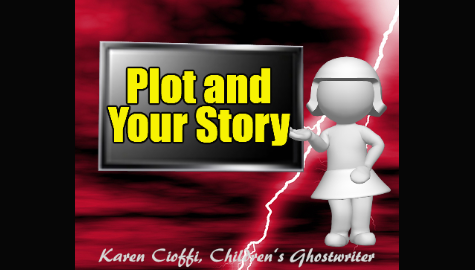Plot. As writers we’ve all heard of this literary term. But, what does it mean?
Well, plot is what gives the story a reason to be. It’s the ‘why’ as to the reason the story exists. Plot is what the story is about. And, if the plot is good, it will entertain and engage the reader. It can even change the reader’s life.
In children’s writing, these stories are usually based on external conflict and action. Think of Superman fighting his nemesis Lex Luther. Or, Sherlock Holmes and Moriarty. And, the conflict doesn’t have to come in the form a person. It can be battling a flood or a volcanic eruption, climbing Mount Everest, or training a crazy, peeing-all-over-the-place dog.
In his book, “Aspects of a Novel,” F.M. Forster said, “A plot demands intelligence and memory also.”
Examples of plot driven stories include:
Madame Bovary – though the plot, Emma is driven toward a tragic end.
Lolita – the plot holds the reader fascinated as Humbert delves helplessly into depravity.
Great Expectations – through the plot, the reader watches Pip live his life in pursuit of having Estella love him.
These stories hold the reader captive. They drive the reader to turn the pages, to find out what will happen to the characters.
According to Children’s Literature.com, there are four types of plot structure:
1. Dramatic or Progress – think of this format as a pyramid.
a. The protagonist starts out okay or is in the beginning of a dilemma – it may be physical or emotional. This is the setup.
b. The obstacles or conflict rise. As each obstacle is met and overcome, another one arises of increasing severity. This goes on to the climax – the top of the pyramid.
c. The climax is the final conflict and has the protagonist giving his all to achieve his goal. It’s win or lose time.
d. Then comes the closing or wrap up of the story. The story descends the other side of the pyramid to a satisfying conclusion.
This is your typical young children’s story structure.
Keep in mind that the scenarios don’t have to be heart stopping action or doom. They can be as simple as a moral dilemma, of doing right or wrong.
2. Episodic – think of this format as a long obstacle course of usually lower impact ups and downs in chronological order. Usually each chapter or section depicts related incidents and has its own conflict climax. The story is connected through the characters and/or the theme.
According to Story Mastery, episodic formats “work best when the writer wishes to explore the personalities of the characters, the nature of their existence, and the flavor of an era.”
3. Parallel – with this format, there are two or more plots. They can be linked by the characters and/or a common theme.
In a recent upper middle-grade book I ghosted, there were three plots connected through characters and the overall plot.
This format can be used for upper middle-grade and young adult stories.
4. Flashbacks – this format provides the reader with flashbacks throughout the story. It allows the writer to begin with an action scene and fill in the ‘why, what, and how’ in flashbacks.
While plot-driven stories are engaging, it’s the stories that combine a good plot with believable characters that the readers can connect to and ‘feel for’ that become memorable. It’s these stories that have the potential to be great.
References:
(1) http://www2.nkfust.edu.tw/~emchen/CLit/study_elements.htm
(2) http://www.storymastery.com/story/screenplay-structure-five-key-turning-points-successful-scripts/
MORE ON WRITING FOR CHILDREN
Become an Author – 5 Basic Rules
Being a Writer – Learn the Craft of Writing
Critiques are Essential for Writers
 Let me take a look at it. I’m a working children’s ghostwriter, rewriter, and coach. I can turn your story into a publishable book you’ll be proud to be author of.
Let me take a look at it. I’m a working children’s ghostwriter, rewriter, and coach. I can turn your story into a publishable book you’ll be proud to be author of.
Shoot me an email at: kcioffiventrice @ gmail.com (please put Children’s Writing Help in the Subject line).
Or, give me a call at 347—834—6700
LIKE THIS POST? PLEASE SHARE!

3 thoughts on “Plot and Your Story – Four Formats”